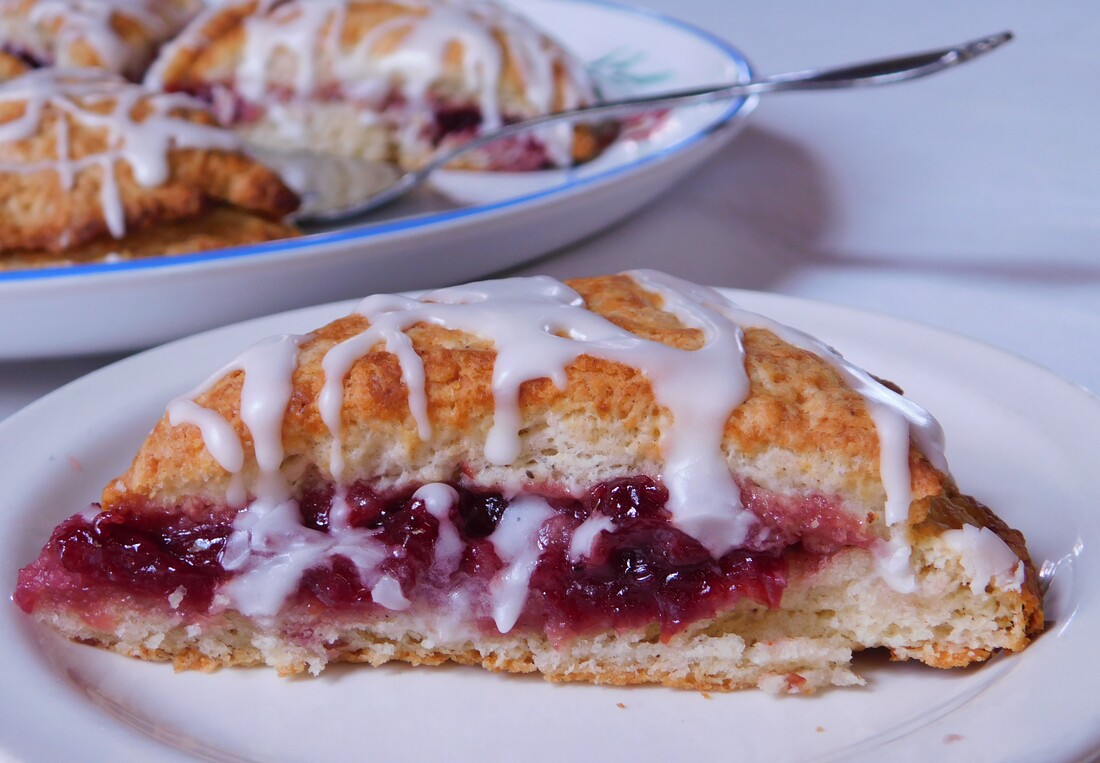Norfolk Scones

Norfolk Scones are made with a fruit filling sandwiched between two layers of dough. You can use pretty much any kind of filling--preserves, compote, cake and pastry filling, etc.--but my two personal favorites are Solo Cake and Pastry Filling and the preserves made by American Spoon in Michigan. And I hasten to assure you that neither company is paying me anything for me to say that! Solo filling comes in strawberry, cherry, apricot, blueberry, raspberry, pineapple, almond, prune and poppyseed, while the Amercian Spoon varieties are somewhat more limited (blueberry lime is a personal favorite). You can even use pie filling but drain off a little of the thick liquid and chop the pieces of fruit a bit smaller.

Norfolk Scones are made with the same dough as Classic Scones, with the usual method of cutting butter into the dry ingredients, then adding an egg beaten together with heavy cream. After a brief kneading, you divide the dough in half, patting one half into an 8" circle on your pan, and the other half into slightly larger circle onto a piece of parchment paper or waxed paper that has been lightly coated with baking spray. It's best to cut the piece of parchment as close to the edge of the dough as possible, as it makes the process easier later on.

The next step is to spread the filling on top of the circle of dough in the pan, leaving a small border around the outside of the circle of dough. I usually use a litrle more than half a cup of filling, but never more than a cup. Too much filling overwhelms the delicate flavor of the scone, in my exprience, and makes them a little messy to eat. Originally, the filling for Norfolk Scones was made with currents, butter, demarara sugar and ginger, but feel free to experiment with whatever you have in the pantry.

Next you are going to pick up the other circle of dough and flip it over onto the filling and peel the parchment paper off. Because you have rolled the top layer slightly larger, it can drape it across the filling and over the side, so you can pinch the dough together to seal in the filling. Notice that you can see bits of butter in the layers of the dough. That's a good sign that you're going to get a flakey result.
Use a sharp knife or a small rotary pizza cutter to divide the dough into eight sections but don't cut all the way to the edge. Leave it connected at the outer edge, or else the top wedges will slide off during baking as the filling heats up and becomes more liquid. You bake these at 400° F. from 20 to 22 minutes.

There are a variety of toppings for a Norfolk Scone. You can drizzle on some powdered sugar icing, as you see here, flavored with vanilla or almond extract depending upon the flavor of your filling. Blueberry filling is complemented by icing made with lemon juice, apricot filling by an orange-flavored drizzle. You can also brush them with cream and sprinkle them with granulated sugar or coarse sugar just before they go in the oven (a classic topping). If you think the filling is sweet enough by itself, you can still get an impressive surface by brushing the tops of the scones with corn syrup heated in the microwave for about 15 seconds, which adds very little sweetness but a lovely shine. This last method should be used just before serving to be most effective visually.




